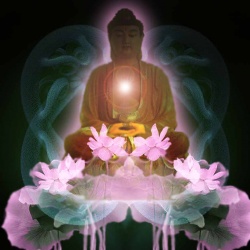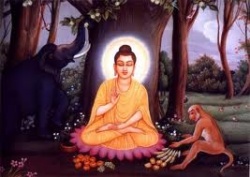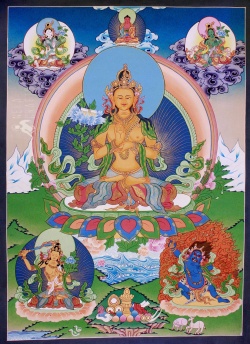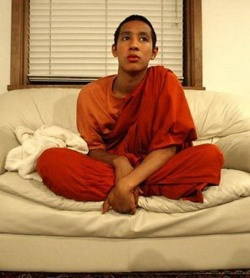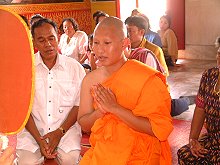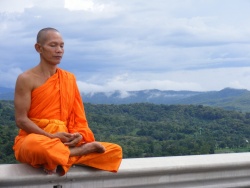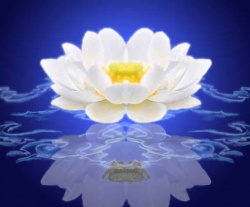Mahamudra Practice
Whether you listen, contemplate, or practice the dharma, it is important to have the motivation of compassion.
And whatever practice you do should be embraced by the three excellences.
In the beginning one should arouse bodhicitta, in the middle one should practice free from reference points, and in the end, one should conclude with dedication.
The excellent preparation of bodhicitta is to practice with the motivation that it will be a cause to bring all beings to full enlightenment, Freedom from reference point is freedom from distraction from the object of meditation.
The excellent conclusion of dedication is to share the merit of the practice for the benefit of the enlightenment of others. If you are not sure how to do that, one can aspire to dedicate merit in the manner of Manjushri and Samantabhadra.
Yesterday I asked you to think about the relation of appearances and mind, thoughts and mind, and moving mind and still mind. When giving pointing out instructions, it's necessary to contemplate the instructions and share your understanding with your teacher.
It is better if you can understand the nature of mind through your experience and not just read about it, because for most people, understanding will not arise just through reading. The understanding that arises through meditation will be without doubt.
[Audience]
Do thoughts only occur in an active mind, like waves on an ocean and a calm mind is like an ocean without waves?
Mind and thoughts seem opposed to each other. Thoughts obscure our true nature. Once thoughts stop, the true nature appears.
You can view them as different. You can't really see mind, but you can see thoughts, but I can't really see mind. Even though thoughts appear, they also can't be found, so they both have the same nature.
The dharmakaya is a still place removed from this sphere. We need to reach a still place, so we can go beyond thoughts.
The mind is a sphere from which thoughts expand and arise. Thoughts are the expression of the mind.
Some days I accomplish things without thinking about them. There's just flow. Is that mind, as opposed to thoughts separated from mind?
Thoughts are the display of the mind. When you see that, you realize thoughts pervade the mind.
Mind is like a piece of tin foil. When it's fresh and shiny it reflects clearly. But thoughts are like wrinkles in the tin foil, so it doesn't reflect well.
I used to think God was everything, nothing and all things in between. Now I think that is a description of the mind.
You should rejoice and happy that you are on the path to realize the nature of mind, which is great bliss. You should be happy because you have seen afflicted thoughts case suffering and that they are not truly real. Understanding this is the path to realize the nature of mind.
All the metaphors in this text for the relation between mind and thoughts partially represent the relation, but not fully. Thoughts are not separate from the mind.
If you see them as separate, that is not correct. Neither mind nor thoughts are truly established as real. They are both the dharmadhatu or buddha nature.
Matripa said: "Adventitious thoughts arise from the unborn. Thoughts themselves are the essential nature of the expanse. From the beginning these two are not different.
The equal taste of the two is my teaching." The same is true of appearance and mind. Matripa said, "The coemergent nature of mind is dharmakaya. Coemergent appearances are the radiance of the dharmakaya. Therefore indivisible appearances and mind are coemergent."
There's another metaphor used, The waves are not separate from the ocean from which they arise. However, if we can't sustain this understanding, mind and thoughts will seem separate, mind and appearances will seem separate, and the still and moving mind will seem separate.
Normally when we ask, no one will say samsara and nirvana are the same. Shavari said that just as all rivers have one taste when they reach the ocean, so do all the mental states have one taste in the dharmadhatu.
There are four sidetracks and three deviation to the practice of mahamudra. The first side track is to hold onto the concept of emptiness. That is true, but merely thinking everything is emptiness is to fall into the extreme of anihilation.
Everything is the unity of clarity and emptiness.
The secondary aspect of this sidetrack is to meditate on emptiness without gathering the accumulations. The second sidetrack is to think the sutras and tantras are antidotes to afflictive emotions, which should be rejected. There are different methods for dealing with afflictive emotions.
But simply rejecting them is a sidetrack. The secondary aspect is to meditate on mahamudra as an antidote to the afflictive emotions. Mahamudra is seeing the nature of whatever arises, including afflictive emotions. Thoughts are the dharmakaya, so they do not need an antidote.
The third sidetrack is to see the ground as inferior, the path as rejecting what is to be rejected, and the fruition as superior.
You shouldn't view the ground as inferior, because it is buddha nature. The ground and fruition are indivisible. The secondary aspect is to practice mahamudra with the hope of achieving the dharmakaya. There is no separation between the practice and the fruition.
The fourth sidetrack is to stamp everything that exists with the seal of non-existence. Just as it is not appropriate to take a non-existent as an existent, it is not appropriate to take an existent as a non-existent. You should not think the deity needs to be dissolved into emptiness.
The secondary aspect is to dissolve entities into emptiness by means of reciting a mantra. All sadhana practices start with a dissolution of appearances into emptiness while saying "all phenomena are pure and have the nature of emptiness."
You shouldn't think this mantra dissolves everything. Everything is empty and we are bringing this truth to mind. We think appearances are real and this is reminding us they aren't.
There are two kinds of pride. One is an afflictive emotion and the other is divine pride. Regular pride is thinking you are what you are not. Divine pride is acknowledging things as they actually are. So these are the four sidetracks.
After the four sidetracks, there are three deviations: into bliss, clarity, and non-thought. Deviation into bliss is clinging to experiences of bliss without bringing them onto the path.
These three deviations refer to experiences that arise during shamatha practice.
When they happen and you find yourself in this state and you become attached to it and try to gain it again, that drives it away, because these experiences arise through not being attached to conceptual thought.
So you should rest in whatever happens in the mind and not seek these experiences.
The deviation to clarity is attachment to the arising of psychic powers, such as reading others thoughts. It's very important to have a lama who has experience on the path and knows what obstacles arise on it.
There is the danger of thinking one is enlightened and becoming arrogant. This blocks progress on the path to awakening.
We can see this in the relation between Gampopa and Milarepa. All sorts of experiences arose and he asked Milarepa about them. Milarepa said they are neither good nor bad, and to keep practicing. Without a teacher Gampopa might have gotten sidetracked.
Deviation into non-thought is to cling to the cessation of thought and the four formless meditations. Also, believing that because all phenomena are empty that there is neither good nor bad is to deviate into nihilistic prattle.
If you hold onto emptiness as a voidness, it leads to attachment to the formless meditations. Instead of leading to liberation, this leads to rebirth in the formless realms.
The description of the formless meditations sounds similar to the explanations of mahamudra, but these explanations are intended for a specific context and cannot be taken as universally valid.
Someone who has the complete realization of mahamudra, that person, who is unaffected by appearances, is not helped by virtuous actions nor harmed by unvirtuous ones. But for ordinary persons, who are bound by appearances to hold that all actions are devoid of kelp or harm is to fall into nihilism.
It's the difference between a peacock who can eat poison, and a person, who cannot. The enlightened person is unaffected by the afflictive emotions.
But as long as we are, we must distinguish carefully between virtue and non--virtue. As our realization grows, our understanding of karma grows more and more refined.
There's a wide range of understanding of karma. Some are more obscured than others. Some believe there is no connection between actions and their results and no next life.
People with this way of seeing things want happiness but lack an understanding of what brings happiness and are anxious in the face of what they see as a nihilistic view.
But someone who understands the relation between actions and their results will be less self-centered, relaxed, and at ease. Someone who doesn't understand karma unwittingly brings about their own suffering.
But someone who does, won't let themselves get carried away by afflictive emotions. It's the difference between driving during the day and driving at night without headlights.
The manner of resting the mind fatigued by the concepts of duality is seeing ordinary mind as fresh, innate, and natural. Normally, when we relax our bodies, our minds are still spinning. What fresh means is resting in the present, without recalling the past or imagining the future.
The innate primordial mind, means what the mind is and always has been. What it means to rest the mind as it is, is to sit down and letting the mind be as it is.
The next topic is the manner of sustaining the practice. I have given some instructions on the mind and you have contemplated them. But is also important to meditate on them. and cultivate the understanding one has.
You might expect one will rest in the stainless, clear, immaculate nature of mind. But achieving this is quite difficult.
And you might think, one could banish all conceptual thoughts, like a Buddha. But that doesn't seem to be the case. The Buddha has uninterrupted mindfulness.
Whether or not you are free of afflictive emotions or not, one should train in being mindful of them and not letting them play out.
Aversion is the foot of meditation, so you should give up attachment to worldly things. You don't need to live in a cave, but you should practice the dharma and not be chasing after worldly concerns. Devotion is the head of meditation, so you should supplicate the Kagyu masters from your heart.
Watchfulness is the main part of meditation, so you should not stray from it. The activity of meditation is compassion, but you shouldn't teach until you have perfected your meditation.
If you do, there is the danger that you will misguide others.
There is a story about Phagmodrupa, who was studying with a Sakya Lama. Phagmodrupa related his experiences to him and the Sakya Lama said he had realized what needed to be realized.
Later he related his experiences to Gampopa and he replied your experiences are worth less than this ball of tsampa I am eating, for it at least can fill my stomach. The armor of meditation is having a conscience and sense of shame.
You should be the judge of your own conduct Others cannot judge, it must come from within. You shouldn't care about the opinion of others.
If you see that you are lessening your afflictive emotions, you should rejoice.
The most profound point is to rely on constant mindfulness. Without constant mindfulness, there is little use in actions of body and speech.
Phagmodrupa said that if mindfulness is sustained, the qualities of a Buddha will arise during the first bardo.
There was a lama who had some realization who told people he would make a footprint in a rock.
But when he tried, it didn't happen. But some lamas do leave footprint, like the previous incarnation of Garchen Rinpoche.
His teacher scolded him as the worst practitioner and sent him away. As he left, he felt distressed and as he walked away, he left a footprint in the rock, as his mind was free of clinging. Then he thought this was a bad thing, he was competing with his teacher, and turned the rock over.
But his teacher knew what had happened and called him back. This is true of all practices. If we conceptualize, no result will come about.
A beginner should look at the mind and relax into the experience of its lack of reality. Whenever you sit down to meditate, the mind uninterrupted by thoughts is ordinary mind.
It cannot be identified by any characteristics. One should rest in this experience. Some teachings I received from Tulku Urgyen said anyone can sustain this experience for a moment or two.
The uncontrived ordinary mind is the nature of mind. Leave it alone without any alteration. But this does not mean letting the mind run loose out of control. So what is this mind like?
Q: How is neutral mind different from unfabricated mind?
A: There is a difference. Letting be is the mind of a Buddha. Neutral mind is a blank mind. Don't understand neutrality as the middle way. It is a fuzzy mind.
Q: Does it take special preparation before you can rest your mind?
A: It is difficult to immediately rest the mind in the natural state.
Q: In the natural state of mind is all confusion is gone and life becomes a practice?
A: Yes.
Q: Is it like when the mind is quiet and free from afflictions?
A: The mind abides in the unity of clarity and emptiness.
Q: What is the unnatural mind?
A: All contrived thoughts.
Q: So everything else is the natural mind?
A: So what is everything else?
Those with a little familiarity of the nature of mind should look nakedly at whatever appears in the mind. Otherwise they should not make a deliberate nature to set the mind.
Those with a lot of familiarity do not need to make any effortful meditation as they are free from clinging to meditation or a meditator.
The single remedy for all afflictions is mahamudra. It is the essence of all Buddhist practice. Milarepa said, by sustaining the ordinary mind, I left ignorance and confusion in the dust.
There is no Buddha other than the ordinary mind. There is not anything better than not clinging to whatever appears.
Even clinging to what is positive obstructs liberation, not to mention clinging to what is negative.
Chains bind one, regardless of whether they are made of gold or iron.
The main point is to cut through attachment. It is holding onto thoughts and emotions that brings suffering. The goal is not to be free of thoughts and emotions but to cut through your clinging to them.
Tilopa said to Naropa, "You are not bound by appearances, you are bound by clinging. Cut through your clinging, Naropa." The mere arising of a thought does not cause suffering. It doesn't matter if you are in a group or in solitude.
You should always sustain the practice of mahamudra. It differs from shamatha, where you may have questions where the mind is meditating or not. In Mahamudra there is no need to doubt, one merely sustains the experience of ordinary mind.
There is no difference between looking nakedly at whatever arises and relaxing loosely.
Relaxing without clinging to whatever appears is effortless mindfulness. There are many instructions for bringing afflictions and adverse circumstances on the path.
But Jigten Sumgon said, "the afflictive emotion is a thought. Ego clinging is also a thought.
To meditate as an antidote is also a thought. I do not consider this stack of three thoughts!" We recognize we have an afflictive emotion and the apply an antidote to it.
But that is piling thought on thought. It is necessary to practice this way as a beginner, but not as a more advanced practitioner.
As a beginner we must apply effort to stop a train of negative thoughts. But a more advanced practitioner should be free from rejecting thoughts or applying antidotes to them. The thought that recognizes a demon is itself the obstacle.
Once Milarepa was meditating in a cave and saw a rock split open. Milarepa thought this must be a demon and the Rock Ogress appeared. He did wrathful practices to avert the demoness, but they did not work. Eventually he rested his mind and the demoness disappeared.
There is no need to rely on anything else at all than resting the mind. It is called the white panacea, after a medicine that would cure all diseases. If you know this remedy, however gross your afflictive emotions are, your realization will be that much stronger.
It is like Angulimala, who instantly saw the truth when it was explained by the Buddha.
It's difficult to overcome conceptual mind and tranform our thoughts into wisdom, because we have a constant chain of them.
But in an instance of strong emotion, it is easier to recognize our minds and transform it.
A moment of anger is unvirtuous if not transformed into wisdom, but it is easier to transform that emotion. Phagmodrupa was teaching a student and making him angry. When he got very angry, he said, now rest in that, and in that way was able to bring him to realization.
Just as manure helps the crops grow, so afflictions can bring forth wisdom. The essential point of practice is to sustain Mahamudra within whatever arises without contrivance.
The five fold path of mahamudra dispels afflictions for those who have not yet achieved mastery, but this is the instruction for those who have achieved mastery. The practice of mahamudra comprises all other practices.
The merit from the authentic practice of mahamudra is greater than kalpas of accumulations of conventional merit.
Just as a lamp dispels the darkness of kalpas, likewise a single moment of a luminous and clear mind dispels the ignorance of kalpas. Mahamudra is the remedy that cuts through the root of all aflictions.
When the root is cut through, the dharmakaya is there in that instant. Even to have a doubtful thought that Mahamudra may be valid is to rent existence apart All the joy of this world and the next are brought forth without exertion.
It destroys the attachment and aversions of the eight worldly concerns. As one's realization of mahamudra grows, naturally one's compassion for those who have not realized it increases.
There are four yogas of mahamudra divided into three stages each, lesser middling and greater. The yoga of one pointedness is the continuous maintenance of samadhi.
The yoga of simplicity is realizing all thoughts and appearances as free from arising and ceasing. The yoga of one taste is realizing all thoughts and appearances as the one taste of mahamudra.
The yoga of non-meditation is when there is no need to maintain mindfulness or rest in equipoise, all appearances arise as meditation. At the highest level all consciousness, even the most subtle is transformed to wisdom.
There are various ways of developing these for persons of higher, middling, and lower capacities. The main practice is to maintain silence and practice in solitary places, to let go of attachment to oneself, enjoyments, and samadhi. The main enhancement is devotion to the guru.
All practices we do are for the purpose of enhancing mahamudra. To realize mahamudra requires the accumulation of merit and devotion to one's teacher.
The yoga of single pointedness corresponds to the path of accumulation.
The yoga of simplicity corresponds to the path of juncture. The yoga of one taste corresponds to the first bhumi.
And the yoga of non-meditation corresponds to the second through tenth bhumis, the path of meditation.
The four yogas also correspond to the four joys of tantra.
Q: Is there a flow chart that explains the various stages of practice?
A: The outline of this text corresponds to the stages of mahamudra practice. It starts with shamatha practice and then the investigation of the nature of mind. Once that is seen it moves onto investigating, the nature of thoughts and appearances, and the still and moving mind. Then it discusses the results of mahamudra practice, the four yogas.
Q: Could you explain the indivisibility of the three times?
A: Ordinary mind is fresh without chasing the past or wishing for the future. That is what me mean.
Q: How does one attain mahamudra at the time of death or in the bardo?
A: When we are alive we have the obscurations of a body of flesh and blood and of being awake. In dreams we have the obscurations of dreams. At death, these obscurations cease so there is the opportunity to become realized by joining the child luminosity with the mother luminosity. But without practice we won't realize that.
Q: How do you choose your yidam?
A: The yidam is innately part of us. Whatever yidam you practice, you actualize that.
Q: How does one achieve the mahamudra state while sleeping? Is it a matter of just practicing when awake?
A: it's important to have the intention to practice during sleep when you are awake.
Drupon Thinley Nyingpo Tibetan Meditation Center June 8, 2008
Source
http://medicinebuddhasangha.org/teachings/mahamudra_practice.html


